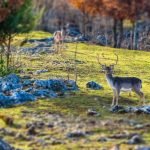Flora
Native vegetation of the Vrlika region comprises a large number of plant communities, or habitat types. According to the data available, in the area of the Dinara mountain there are around 750 plant species, of which more than 110 are strictly protected and 55 are endemics.
The flora comprises:
- Mountain Grasslands
- Scopoli’s Rock Cress
- Dinarian Mouse Ear
- Dalmatian Rockbell
- Pasque Flower
- Lion’s Paw
- Yellow Gentian
- Common Juniper
- Hairy Azalea
Fauna
1. Birds
In terms of ornithology, the Vrlika region, particularly the peaks and the slopes of the Dinara mountain appertaining to it and the habitat around the Upper Cetina, from its source to the Peruća dam, is designated as a Special Protection Area (SPA) according to the EU Directive on the Conservation of Wild Birds.
The bird species include:
- Shore Lark
- Redshank
- Stone Curlew
- Moustached Warbler
- Short-toed Snake Eagle
2. Mammals
The mammals of the Vrlika region are:
- Brown Bear
- Grey Wolf
- Eurasian Lynx
- Wildcat
- Red Fox
- Wild Boar
- Eurasian Badger
- Brown Hare
- Balkan Snow Vole
3. Insects
The relatively well-preserved, extensive and diverse habitats of the Dinara and Svilaja mountains and the Upper Cetina provide a refuge to a number of invertebrate species whose natural habitats have been endangered due to specific living conditions they require, while many of them are endemics and placed on the Red List (certain species of caddisflies, dragonflies, stoneflies, orthoptera, etc.).
Invertebrates living in caves and holes make a special group – their biology remains relatively unknown, but they are protected as the cave fauna together with cave vertebrates.
Insects include:
- Dalmatian Ringlet
- Rosalia Longicorn
- Longhorn Beetle
- Firebug
- Hornet
- Bumblebee
- Stag Beetle
- Marsh Fritillary
4. Herpetology
The herpetofauna of the Vrlika region comprises around 15 species of lizards, snakes and amphibians, some of which are endangered, mostly due to the fact that their natural habitats have been either reduced in extent or suffered degradation.
The herpetofauna comprises:
- Smooth Snake
- Balkan Whip Snake
- Nose-horned Viper
- Fire Salamander
- Slow Worm
- Karst Meadow Viper
- Alpine Newt










